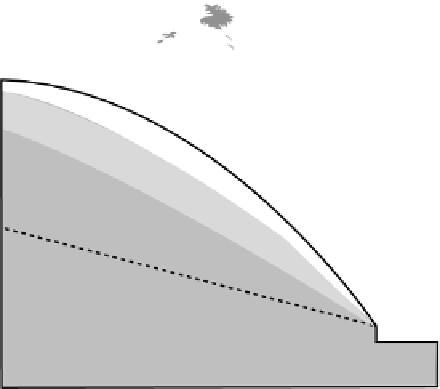Geoscience Reference
In-Depth Information
6.7
Land surface
6.7.1
Hydrology
Fertility and permeability of bedrock
Bedrock mineral alteration by percolating groundwater
Production of surface biomass through ecological
energetics of plant productivity
Breakdown of dead plant biomass through respiration
Gravitational force components available to water fluxes
down hillside slopes
Thus, in a way, the catchment creates the landscape
from a number of prior conditions, rather analogous to the
“Nature versus Nurture” concept for individual animal
development. The genetic makeup of an individual (nature
providing) is acted upon by external circumstances (nur-
ture modifying). Tectonics, climate, and geology are any
given landscape's “genes,” while water : rock and
water : organic reactions, groundwater throughflow, sur-
face runoff, gravity slope, mass movements, and sediment
transport are the environmental variables that nurture and
modify.
First let us consider the nature of the aerated soil water
that lies in partially filled pore spaces above the water table.
This may reside in soil, sediment, or chemically altered
bedrock termed
saprolite
. A mature, well-developed soil
with plentiful
in situ
organic and clay fractions and a natural
The
hydrological cycle
on land (Fig.
6.56) involves
consideration of:
Interception of precipitation by vegetation
Utilization of water by vegetation in the photosynthetic
cycle through evapotranspiration
Surface runoff as overland flow
Subsurface percolation and soil water throughflow
Groundwater flow and groundwater seepage to river
channels to make up streamflow
All this takes place within the spatial entity known as a
drainage catchment
, countless of which cover the entire
land surface of the Earth. However, it is a grave mistake to
assume that the hydrological cycle in a catchment is simply
a kinematic concept. Although it is a balancing budget
exercise for water where
Input
Storage
, it is
also highly dynamic, with both potential, kinetic, and ther-
modynamic energy transfers and transformations taking
place constantly within the system (Fig. 6.57). Thus within
each catchment the balance of water flux and storage is
determined by a unique and self-sustaining combination of:
Ambient temperature from solar radiation balance
Magnitude of incoming water supply determined by
climatic/meteorological conditions
Output
Monthly ppt and temperature
Transpiration
Canopy
Evaporation
Rainfall
Solar irradiance
Dry deposition
(Wind blown dust)
Temperature
control of
reactions
Vegetation
st
Soil
evoparation
st = Store
Biomass
changes
Erosion
Runoff
Through
flow
Evapotranspiration
Rock
weathering
Soil
st
Soil
Soil
Sol
n
.
Litter
decomposition
Rate soil
production
Mineral reactions
Vadose
zone
Saprolite
Overland
flow
Through
flow
Direct
recharge
Phreatic
zone
Mineral reactions
Stream
flow
Rock
Through
flow
Bedrock
Saturated groundwater flow
Recharge
Fig. 6.56
The hydrological variables of a hillslope system.
Fig. 6.57
Flow chart for use in water modeling.












































































Search WWH ::

Custom Search